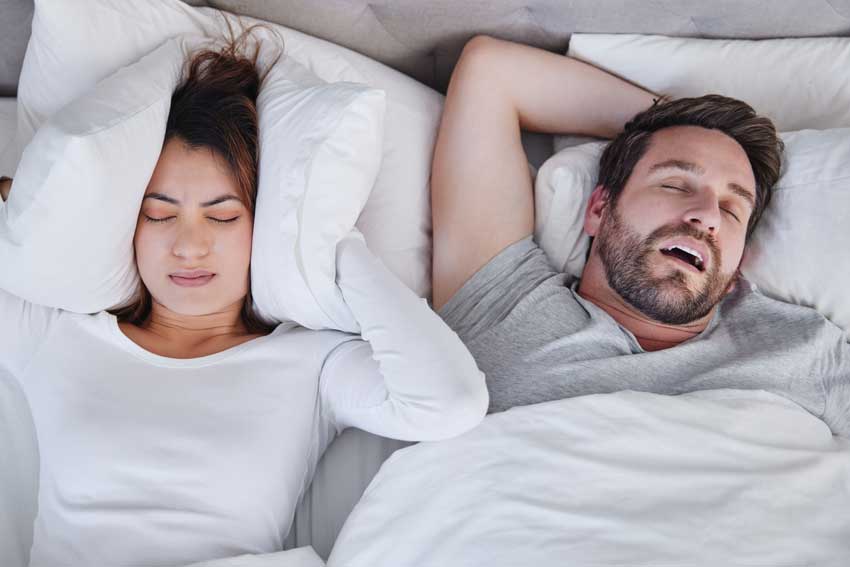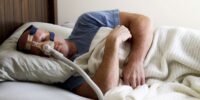Why Is Sleep Position Important For Sleep Apnea Sufferers?

Sleep apnea is a common sleep disorder that affects millions of individuals worldwide. It is characterized by repetitive pauses in breathing during sleep, leading to fragmented sleep and reduced oxygen levels in the body. Sleep position has been recognized as an important factor in managing sleep apnea symptoms and improving sleep quality for sufferers.
This article aims to explore the relationship between sleep position and sleep apnea, emphasizing the role of sleep position in reducing apnea episodes. Additionally, it will provide tips for finding the right sleep position and suggest other lifestyle modifications that can help alleviate sleep apnea symptoms.
Sleeping on the side, in particular, has shown to be beneficial for sleep apnea sufferers. However, it is important to consult with a healthcare professional for personalized advice and guidance in managing sleep apnea effectively.
By understanding the importance of sleep position, individuals with sleep apnea can take proactive steps to improve their sleep quality and overall well-being.
Key Takeaways
- Sleep position plays a crucial role in managing sleep apnea symptoms and improving sleep quality.
- Sleeping on the side is beneficial for sleep apnea sufferers as it reduces airway collapse and the number of apnea events.
- Finding the right sleep position, such as sleeping on the side and elevating the head, can help prevent airway obstruction and improve oxygen saturation levels.
- Consulting with a healthcare professional is essential to receive personalized advice and recommendations based on individual needs, including lifestyle modifications, CPAP devices, and surgical interventions.
Understanding Sleep Apnea and its Impact on Sleep Quality
Sleep apnea is a common sleep disorder characterized by repeated episodes of breathing cessation during sleep, which can significantly disrupt the quality of sleep experienced by individuals.
This disorder is caused by the relaxation of the muscles in the throat, leading to the narrowing or complete closure of the airway.
As a result, individuals with sleep apnea may experience loud snoring, gasping for air, and frequent awakenings throughout the night.
The impact of sleep apnea on sleep quality is substantial, as these interruptions prevent individuals from entering deep, restorative stages of sleep.
This can result in daytime sleepiness, difficulty concentrating, and an increased risk of accidents and health problems.
Therefore, understanding sleep apnea and its impact on sleep quality is crucial in order to develop effective treatment strategies and improve the overall well-being of affected individuals.
The Relationship Between Sleep Position and Sleep Apnea Symptoms
The correlation between the body’s posture during sleep and the severity of symptoms associated with obstructive sleep apnea has been extensively examined. Understanding this relationship is crucial for sleep apnea sufferers seeking to improve their sleep quality.
Here are four key points to consider:
- Supine position: Sleeping on the back, known as the supine position, is often associated with increased apnea events. This position promotes gravity-related collapse of the upper airway, leading to more frequent breathing pauses during sleep.
- Side sleeping: Shifting to a side sleeping position can significantly reduce the number of apnea events. This posture helps keep the airway open and decreases the likelihood of obstruction.
- Pillow support: Proper pillow support can further enhance the effectiveness of side sleeping. Elevating the head slightly with a firm pillow can help maintain a clear airway and reduce apnea symptoms.
- Positional therapy: For some individuals, positional therapy may be recommended. This involves using positional devices, such as specialized pillows or vests, to encourage side sleeping and discourage sleeping on the back.
By understanding the relationship between sleep position and sleep apnea symptoms, individuals can make informed choices to improve their sleep quality and overall well-being.
The Role of Sleep Position in Reducing Apnea Episodes
Side sleeping has been shown to significantly decrease the frequency of breathing pauses during sleep and can evoke a sense of relief and hope for individuals experiencing apnea episodes. Sleep position plays a crucial role in reducing apnea episodes by promoting better airflow and reducing airway collapse.
When sleeping on the side, the gravitational force helps to keep the airways open, preventing obstruction and allowing for more efficient breathing. This position also helps to minimize the relaxation and collapse of the tongue and soft tissues in the throat, which are common causes of sleep apnea.
Moreover, side sleeping can improve oxygen saturation levels and decrease the severity of apnea events. It is important for sleep apnea sufferers to be educated about the benefits of side sleeping and encouraged to adopt this position during sleep to optimize their breathing and overall sleep quality.
Tips for Finding the Right Sleep Position
An optimal sleep posture can greatly enhance the quality of rest and reduce the frequency of breathing pauses, making it crucial to explore various tips to find the right sleep position.
Here are three tips to help sleep apnea sufferers find the most suitable sleep position:
- Sleeping on the side: This position can help prevent the collapse of the airways, as it keeps the tongue and soft tissues from obstructing the throat. Using a body pillow or placing a pillow between the knees can help maintain this position throughout the night.
- Elevating the head: Sleeping with the upper body slightly elevated can reduce the chances of airway obstruction. This can be achieved by using a wedge pillow or raising the head of the bed. It helps keep the airways open and promotes easier breathing.
- Avoiding the supine position: Sleeping on the back can worsen sleep apnea symptoms as the tongue and soft tissues are more likely to obstruct the airways. Using a tennis ball or a specialized sleep shirt with a pocket to hold a ball can discourage supine sleeping.
By incorporating these tips into their sleep routine, individuals with sleep apnea can optimize their sleep position and potentially improve the quality of their sleep.
Other Lifestyle Modifications to Improve Sleep Apnea Symptoms
Implementing certain lifestyle modifications can be beneficial in managing the symptoms of sleep apnea. In addition to finding the right sleep position, there are other lifestyle changes that can improve sleep apnea symptoms.
One important modification is maintaining a healthy weight. Obesity is a risk factor for sleep apnea and losing excess weight can alleviate symptoms.
Regular exercise can also be helpful as it improves overall cardiovascular health and can contribute to weight loss.
Avoiding alcohol and sedatives before bedtime is another important modification. These substances relax the muscles in the throat, making it more likely for apnea episodes to occur.
Finally, quitting smoking can also be beneficial, as smoking can increase inflammation and fluid retention in the airways, worsening apnea symptoms.
By implementing these lifestyle modifications, sleep apnea sufferers can potentially improve their sleep quality and overall well-being.
The Benefits of Sleeping on Your Side for Sleep Apnea Sufferers
Sleeping in a lateral position has been shown to offer significant benefits in managing the symptoms of sleep apnea. This sleep position, where an individual sleeps on their side, can help alleviate the obstruction of the airway that occurs in sleep apnea.
The benefits of sleeping on your side for sleep apnea sufferers include:
- Reduction in the number and severity of apnea episodes during sleep.
- Improved oxygenation of the body, as the lateral position allows for better airflow.
- Reduced snoring, a common symptom of sleep apnea, as sleeping on the side helps keep the airway open.
These benefits can lead to better sleep quality and improved daytime functioning for individuals with sleep apnea. It is important for sleep apnea sufferers to consider adjusting their sleeping position to optimize their treatment outcomes.
Consult with a Healthcare Professional for Personalized Advice
Continuing on the topic of the benefits of sleeping on your side for sleep apnea sufferers, it is important to note that individual circumstances may vary. Hence, consulting with a healthcare professional is paramount to receive personalized advice regarding sleep positions.
Healthcare professionals possess the necessary knowledge and expertise to evaluate the specific needs of each patient, taking into account factors such as the severity of sleep apnea, body structure, and coexisting medical conditions. By seeking professional guidance, sleep apnea sufferers can receive tailored recommendations that cater to their unique circumstances.
Additionally, healthcare professionals can provide valuable insights into other aspects of sleep apnea management, such as the use of continuous positive airway pressure (CPAP) devices, lifestyle modifications, and potential surgical interventions. By availing themselves of professional advice, sleep apnea sufferers can optimize their sleep positions and overall management of the condition.
Frequently Asked Questions
Can sleep position alone completely cure sleep apnea?
No, sleep position alone cannot completely cure sleep apnea. While sleep position can play a role in managing the condition, other factors such as obesity, airway structure, and underlying medical conditions need to be addressed for effective treatment.
What are the best sleep positions for sleep apnea sufferers?
The best sleep positions for sleep apnea sufferers are side sleeping and elevating the upper body. These positions help to keep the airways open and reduce the likelihood of breathing obstructions during sleep.
Are there any specific pillows or sleep aids that can help with sleep apnea?
There are specific pillows and sleep aids designed to assist with sleep apnea. These aids, such as cervical pillows or wedge pillows, help to keep the airways open and improve breathing during sleep, thus reducing the symptoms of sleep apnea.
How long does it typically take to see improvements in sleep apnea symptoms by changing sleep positions?
Improvements in sleep apnea symptoms by changing sleep positions can vary greatly among individuals. It is important to note that sleep position alone may not be sufficient, and a comprehensive treatment approach should be pursued to effectively manage sleep apnea.
What are the potential side effects of sleeping on your side for sleep apnea sufferers?
Sleeping on your side can help reduce the severity of sleep apnea symptoms by keeping the airway open. However, potential side effects may include discomfort, pressure points, and increased risk of shoulder and hip pain.











